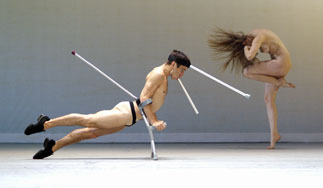bODY rEMIX: Variations on Every Body

MARYSE:
I had seen the images for months. Svelte dancers bound and supported by prostheses and canes. They had created quite a stir in the national dance community. It wasn’t just the imagery. I had heard about Marie Chouinard’s new piece bODY rEMIX through various channels, it is a piece that has gathered critical acclaim across Canada.
ALLYSON:
There was definitely a lot of buzz about this show... and I can tell you one reason why. bODY rEMIX is one of the first times I’ve had the chance to see a full-length dance piece on a large stage – the production was held at the Vancouver Playhouse – with a company of eleven performers! It was wonderful to see so many dancers on stage. In Vancouver, it’s much more common to see one, two, three, maybe six dancers.
MARYSE:
I have to echo Allyson’s words at the delight of seeing eleven (eleven!) dancers on a large stage with high production values enabled by a Quebecois-sized budget. There is something about this type of experience that simply cannot be recreated in a venue like the 175-seat Roundhouse Arts and Recreation Centre. Don’t get me wrong – exposed brick has its time and place, but not for this type of work which demanded a larger canvas.
ALLYSON:
With this piece, the Playhouse stage definitely helped to support the choreographer’s unusual artistic vision. In addition to the crutches and prostheses, the dancers wore revealing costumes that were mere strips of fabric, binding their bodies. It seemed like their bodies were held together by the tautness of the strings. In contrast to classical ballet, the dancers’ movements had a distinct lack of symmetry which was often emphasized by their strange prosthetic attachments. They struggled to dance gracefully in one bare foot and one ballet pointe (a hard-toed shoe allowing the dancer to stand on the tips of their toes while performing steps). It must be incredibly difficult to dance against your training... you have to be an excellent dancer to create deliberately awkward movement.
MARYSE:
bODY_rEMIX is definitely meant to be an insider’s portrait of the ballet world, but the portrait is more Diane Arbus, photographer of freaks and weirdos than Annie Liebowitz, photographer of Hannah Montana and Arnold Schwarzenegger. Chouinard’s choreography forced the dancers into awkward positions, maintained and emphasized with the use of prostheses, crutches, walkers and ropes. The extra limbs and sharp movement caused the dancers to appear insect-like and strange. At one point in the first half, two dancers appear as conjoined twins bound at the hip with gauzy cloth. Throughout the work, dancers hobble around, wrapped in the strips of fabric Allyson mentions and appear vulnerable yet strong at the same time. It was certainly a testament of the pain and disability caused by the rigors of classical ballet. When the whole hoard of dancers moved across the stage, it felt like the circus had come to town and left all the freaks behind looking for their caravan.
In other words, it was marvelous.
ALLYSON:
Dancers are freaks to many of us whose physical existence revolves around a computer and a chair. I felt like I was somehow spying on something very private – the ritual of creation and the sheer effort required by these dancers to sustain such unnatural movements. At times, it was overpowering, exactly like watching a contortionist bend into a position that I did not think possible for the human body to achieve. When I watched, I wondered about the curious tension between freedom and restraint – does adding metal implements to the human body create increased or decreased ability? The answer seems to be both. And this builds on the theme of the brutality of classical ballet – an art form enabled by dancers who wear pointe shoes. Dancing en pointe can be liberating and expressive, yet simultaneously cause pain to the dancer. For the professional dancer, pain is a fact of life. It reminded me of the extreme discipline demanded of dancers… years and years of classes followed by performances which require a dancer to push to his/her very limits.
MARYSE:
Throughout the piece I tried to keep in mind how it related to the music, reflected in the title. Johann Sebastian Bach’s The Goldberg Variations, and Louis Dufort’s Variations on the Variations were combined with the distorted voice of Glen Gould. The music seemed industrial and the movement often mimicked its repetitive nature. What struck me most, however, was one of the looped recordings of Gould speaking, telling us about the importance of variations and how breaking away from the norm is at the root of art and creativity.
This is what made this work so appealing – not only is the company made up of amazing dancers, Chouinard’s choreography has begat a truly creative piece, with movement that strayed from the usual repertoire of contemporary dance. A repertoire that becomes so tiresome, so quickly. Seeing a company from out of town reminds me how much choreography and movement gets recycled locally from company to company. bODY_rEMIX/ gOLDBERG_vARIATIONS was, for me, a welcome variation.
Credits:
COMPAGNIE MARIE CHOUINARD
bODY_rEMIX/gOLDBERG_vARIATIONS
Vancouver Playhouse May 2 & 3, 2008
Co-presenters: Dance House and Dancing on the Edge
Artistic Director and Choreographer: Marie Chouinard
Production Director: Guylaine Savoie
Dancers: Kimberley de Jong, Mark Eden-Towle, Masaharu Imazu, Carla Maruca, Lucie Mongrain, Carol Prieur, Manuel Roque, Dorotea Saykaly, James Viveiros, Won Myeong Won, Kirsten Andersen (maternity leave)



